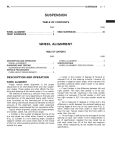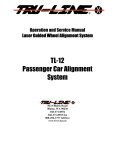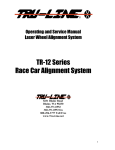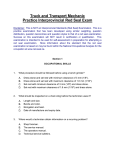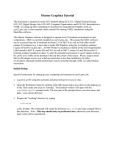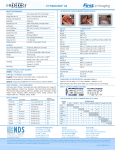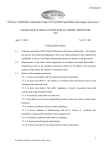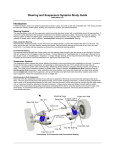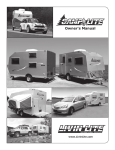Download Questionable Alignment Readings using an Imaging System
Transcript
Release Date: July, 2012 Priority Status: When Subject Exist Model(s) Affected: Calibration Procedure Sales Bulletin q q q Service Bulletin q Part / Accessory R Service Procedure q q New Product Release Operation Procedure All Imaging Aligners WA-1166 Questionable Alignment Readings using an Imaging System GENERAL OVERVIEW:________________________________________________________ When a customer complains of crooked steering wheels or questionable alignment readings the problem is often not with the alignment machine. In general, the technician should assume that the alignment machine is correct until proven otherwise. The following list details items to be checked and verified prior to replacing parts or calibrating the unit. Each situation is different however we highly recommend that each of the steps listed in this guide be completed. It is highly possible to have more than one problem. ACTION TO BE TAKEN:_______________________________________________________ Items to check on the Alignment Machine 1. Use your service vehicle to generate a complete set of alignment readings on a known good aligner. Print the results for future reference. Update your service vehicle’s alignment readings on a regular basis. 2. Use your service vehicle to generate a complete set of alignment readings on the suspect unit. Compare the results to that of the known good unit as described in step 1. If the readings agree the problem is not likely to be with the alignment machine. 3. Check that the wheel clamps are centering properly and that there are no loose, worn or damaged parts on the clamp. See Service Bulletin WA-1132 for details. 4. Check the clamps for proper location. The longer grabber brackets are used on the front axle, the shorter grabber brackets are used on the rear axle. Note that this does not apply to UHR units, however each target and clamp is assigned a separate wheel position with UHR. 5. Check that the targets are in good condition and are firmly secured to the wheel clamps. 6. Using Data Examination check that the RMS, Blobs and Strobe parameters are nominal for each target. See the appropriate Service Manual for details. Items to check on the Alignment Rack 1. Ensure that the turn plates move freely and have an adequate range of motion. Older turn plates may have insufficient travel. Turn plates should be checked under load with a vehicle on the rack. 2. Ensure that the slip plates move freely and have an adequate range of motion. Slip plates should be checked under load with a vehicle on the rack. 3. Ensure that the rack is reasonably level and does not move or twist when under load. Runways, turn plates and slip plates may undergo camber changes when under the load of a vehicle. 4. Verify lock consistency by entering the All Readings screen and observing for camber changes at all lock positions. Copyright © 2012 Snap-on Equipment. rjh.. All Rights Reserved 1 5. Ensure that the rack is parallel and level across the runways. 6. Ensure that the rack is coplanar. Use the Rack Check test located in Diagnostics to check for coplanar runways. Note that Rack Check is not available on UHR models. Test the rack for coplanar with a 4 foot level on UHR units. Calibration Checks 1. Perform a rollback using a vehicle with no worn or loose suspension parts. Insure that the suspension is settled properly. Proceed to Rear Meters. Roll the vehicle back and forth a few times while observing the meters for changes in camber or toe. Changes in camber or toe greater than 0.05 degrees indicate a Target Identification (TID) problem. Repeat this test while observing the Front Meters. The unit must be set to read in high resolution. 2. UHR ONLY. Simulate a rollback while in Data Examination. The RMS values should not exceed 0.14 on any target during the rollback process. Higher RMS values indicate that TID should be performed on the effected target or targets. 3. Using the same vehicle enter the Vehicle Dimensions screen (if available). Errors in Wheel Base greater than 0.2 inches may indicate a problem with Relative Camera Positioning (RCP). Calibration Notes If all of the above items have been checked the unit may require a calibration. The existing calibration should be backed up prior to performing a Target Identification (TID) or Relative Camera Positioning (RCP) procedure. See the appropriate Service Manual for details. Note: That RCP and TID procedures are conducted at the factory prior to shipping the unit. The procedures used at the factory are more accurate than field procedures due to the greater degree of precision of the factory fixtures. Calibration should only be performed when required due to parts replacement or when the items listed above fail to resolve the problem. If calibration is required it is preferable to perform a TID procedure before attempting an RCP. If the problem can be attributed to one wheel it is possible to TID that wheel only. When doing a TID the vehicle being used must not have any worn parts. The vehicle must be lowered on one of the locks of the jack beam. Failure in any of these steps can and will result in an error of the TID process. Test the unit in question after the TID is performed. Perform an RCP only if the TID procedures failed to solve the problem. UHR only. All four sets of targets must be done on the front wheels only. When doing a TID on a UHR system NO OTHER target can be in the cameras field of view during the process of an individual TID. Failure to follow these procedures can and will result in errors. Items to check with the Operator Ask the operator to perform an alignment procedure. Observe that the operator is using proper procedures during the alignment process. Items to check include: 1. Does the operator pull on to the rack with no sharp turns or corrections? Sharp turns can bind the vehicle suspension. Rolling the vehicle back and forth a few times on the runways will help to relax the suspension. 2. If the vehicle has been elevated prior to conducting measurements, insure that the operator has jounced the vehicle thoroughly. Roll the vehicle back and forth a few times on the runways to help to relax the suspension. In some cases the vehicle may need to be removed from the rack, driven and then put back on the rack before conducting measurements. 3. Inspect the vehicle for loose or damaged suspension parts that could move during alignment procedures and cause repeatability issues. Copyright © 2012 Snap-on Equipment. rjh.. All Rights Reserved 2 4. Check that the tire pressures are set to manufacturers specifications. Air pressure in tires on the same axle should be equal. 5. Ensure that the vehicle does not have mismatched wheels or tires. Tires must be the same size on each axle. Ensure that the wheel and tire types on each axle are the same. Note that wheel and tire type or size can vary between front and rear axle, but wheel size, type and tire size must be the same for both wheels and tires on the same axle. 6. Ensure that the Targets and Wheel Clamps are mounted properly. All grabbers must be set in either the normal or the over the hub cap position. All grabbers must be seated in the inside bracket position or all grabbers seated in the outside bracket position for proper target centering. 7. Ensure that the rack is firmly on the locks before making any measurements or adjustments. 8. Ensure that the operator does not jerk or jounce the suspension during the rollback procedure. 9. Ensure that Wheel Wobble is turned on (Pro-42 units) and that Wheel Wobble warnings are not bypassed. 10. Ensure that the turn plate and slip plate pins are removed after Rollback. 11. Ensure that all instructional prompts such as install the brake pedal depressor, install the steering wheel holder or jounce the suspension are being followed by the operator. 12. If performing a Caster Swing, ensure that any Wheel Roll Detected messages are not ignored by the operator. 13. Ensure that the operator is using proper methods to center the steering wheel. See Service Bulletin WA1116 for details. 14. Recommend that the operator use EZ-Toe. This is required for vehicles equipped with Electronic Power Steering (EPS) units. Note that it is not required that the vehicle be steered when using EZ-Toe. 15. If toe is to be adjusted ensure that the operator loosens the adjusting sleeves on both sides before attempting any adjustments. 16. If the operator is using an Elevated Adjust assistant be sure that the screen prompts are followed exactly. Ensure that the turn plate and slip plate pins are removed before lowering and jouncing the vehicle. 17. Ensure that the operator is not adjusting toe while elevated. The toe meters are for reference only when using an Elevated Adjust assistant. 18. When applicable to the vehicle ensure that the operator is using the Drag Link or Single Tie Rod Adjustment Assistants. This will help to maintain accuracy and repeatability with these types of vehicle. Copyright © 2012 Snap-on Equipment. rjh.. All Rights Reserved 3



